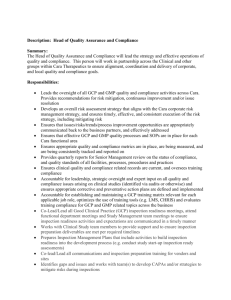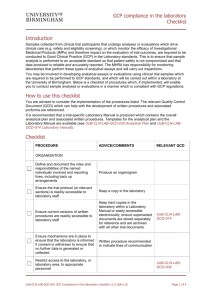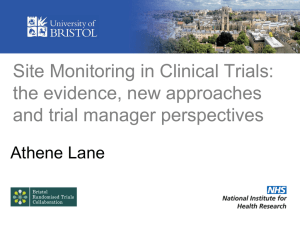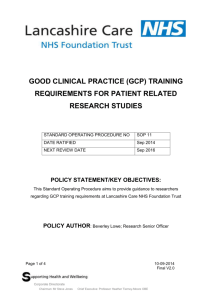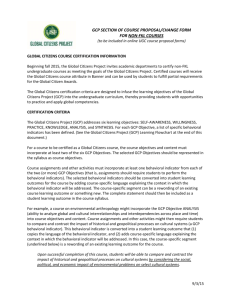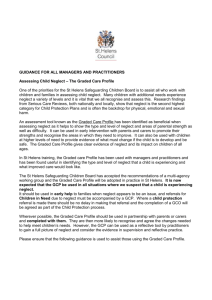Regulatory Requirements for Ensuring Quality by Fergus Sweeney
advertisement
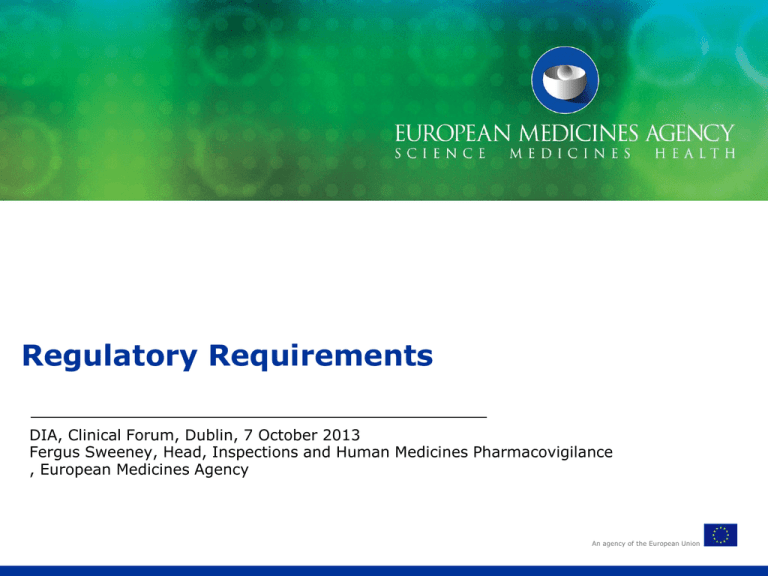
Regulatory Requirements DIA, Clinical Forum, Dublin, 7 October 2013 Fergus Sweeney, Head, Inspections and Human Medicines Pharmacovigilance , European Medicines Agency An agency of the European Union Disclaimer The views presented in this presentation/these slides are those of the author and should not be understood or quoted as being made on behalf of the EMA and/or its scientific committees 2 Regulatory Requirements and guidelines for quality of design • Directive 2001/83/EC Annex 1 • Directive 2001/20/EC and directive 2005/28/EC • General guidelines – GCP, Statistical analysis, Clinical study report, Clinical trials in paediatric or elderly populations • Guidelines on clinical development of medicinal products in specific therapeutic areas • Scientific advice (non-binding) – optional possibility for sponsor to seek scientific advice on the development of a medicine - clinical, pre-clinical, pharmaceutical 3 Regulatory requirements for clinical trial design • Legislation is general – broad principles. • More information is in guidance – but it still offers considerable flexibility. • Guidance leaves much to be defined by the sponsor in their policies, processes and procedures. Better alternatives can be justified case by case. • The detail or complexity of trial conduct is driven by established practice, perceived requirements, “the oral and written culture” which is very open to change. Many of the issues lie in this “cultural” category as do the obstacles to change. 4 Defining Quality Quality sufficient to support the decision making process on medicines throughout the clinical development and use post-marketing authorisation Collecting data, generating information, enabling decision making by: • • • • • • • Sponsors Ethics Committees Regulators Investigators Healthcare professionals Study subjects Patients Ensuring: •Subject rights, safety and welfare •Robustness of data 5 Current Developments 6 Current developments – helping to make that flexibility clear and put into practice • EU GCP IWG/CTFG draft Reflection paper on risk based quality management – publication soon • OECD Recommendation on risk based approach endorsed – final recommendation published 10 Dec 2012 • FDA Guidance for Industry on Risk based approaches to monitoring – published August 2013 • EU GCP IWG / CHMP “Points to consider on GCP inspection findings and the benefit-risk balance” Final – publication in coming weeks • EU Draft regulation on clinical trials 7 8 “Points to consider on GCP inspection findings and the benefit-risk balance” • Agreed by GCP IWG, adopted by CHMP November 2012. • It is a Discussion paper on key GCP inspection issues impacting risk / benefit considerations by CHMP. • Objective - to assist inspectors and assessors in evaluating the consequences of inspection findings in relation to the benefit-risk balance. Building prioritisation and risk assessment into conclusions and decisions based on inspection. • Three categories are used: – Inspection findings which are likely to influence the benefit-risk evaluation – Inspection findings which may influence the benefit-risk evaluation – Inspection findings which are less likely to influence the benefit-risk evaluation 9 Introduction • Many non-compliances may result in increased variability/reduced precision • May blur real differences between treatment groups • For superiority studies , if superiority has been established, non-compliances which increase variability, but not introducing bias favouring one treatment over the other are relatively unproblematic • For non-inferiority studies. Increased variability may disguise a real difference between products. On the other hand, increased variability tends to widen the confidence interval for the mean difference/ratio between the test and comparator making the non-inferiority claim more difficult to obtain. • Non-compliance in the intermediate and low-impact category may not affect the benefit-risk assessment looked upon in isolation. • Major ethical flaws have an impact on the final conclusions about approvability of an application. Consequently, ethical misconduct could result in rejection of the application. 10 11 Final Version Agreed and published: 13 Picture of new CT regulation 14 Draft regulation on clinical trials. for co-decision by Council and Parliament • Single dossier, single application portal for EU, encompassing regulatory and ethics review. • Joint assessment of core information Part 1 between involved member states and national assessment of Part 2. Single decision per trial and per member state. • Low intervention trials – marketed product within SPC or established medical practice – rapid assessment, dossier is simple, additional labeling only if required by study design. • Emergency treatment trials • Insurance, labeling • Improved framework for safety reporting 15 16 Some data from inspection findings 17 GCP inspections requested by EMA 2012 Monitoring findings Critical Major 145 Minor 87 Total 18 45 277 2000- Anaylsis • Based on verbatim finding only • Review of supporting evidence not yet included • Some items “insufficient monitoring” are further detailed in the report but not in the database – need more investigation • Minor findings not reviewed 19 GCP inspections requested by EMA 2012 Monitoring findings Finding type Critical 2000- Major Total Monitor did not report/act on problems 8 20 28 Deficient SDV 9 15 24 Insufficient Monitoring 5 34 39 No action by sponsor 7 10 17 Failure to visit lab or other technical facility 2 7 9 Failure to visit sub-investigator sites 3 4 7 11 32 43 0 17 17 Late to start, big gaps, not to plan IMP related issues 20 If you don’t have a monitoring plan …and even when you do it is not followed… ……and even when it is followed its feedback loop is not acted on…… ………and key areas are omitted from the plan… • Correct planning, design, priority setting and risk management would enable sponsors to: • ensure staff focus on what matters, • be more effective, • deliver good data, • convince regulator that process is in control • and that the choice of priorities is correct • and risk mitigation appropriate. 21 Analysis of inspection findings on monitoring and of other key areas. • What are the issues for sponsors to improve? • What are the issues for regulators to improve? • Do they already have the correct emphasis? • What were the major regulatory impacts – relationship between GCP non-compliance and marketing authorisation outcome? • Scientific advice is linked to better outcome at MA – do sponsors who seek SA also fare better on inspection? 22 Thoughts for the day and for the future 23 Heisenberg uncertainty principle • uncertainty principle - mathematical inequalities asserting a fundamental limit to the precision with which certain pairs of physical properties of a particle can be known simultaneously (e.g. position and momentum). • observer effect the impact the act of observation has on a phenomenon being observed. – Querying, monitoring, auditing - by sponsors – Reviewing, questioning, inspecting – by regulators – All change behavior – people change the way they work, organizations change emphasis and process based on these. – All these are usually addressed with emphasis on negative rather than positive aspects – Beware of unintended consequences 24 Quality in clinical trials Trial Design and Trial Initiation Trial Conduct Data Evalution and Writing of Clinical Trial Report Regulatory Submissions and/or Publications Prioritization and risk mitigation approaches across several dimensions: – – Protection of trials subjects Rights, Safety, Integrity, Credibility of data and results Stratified according to knowledge of product (MA status): – Medicine authorised in EU used within terms of MA or within established treatment regimen – Medicine authorised in EU used significantly outside of MA, Medicine without MA in EU Customized approach depending on: 25 – Protocol complexity, extent of interventions related to trial – Therapeutic indication and nature of endpoints, including population and co-medications – Administration of the product, dose, formulation – Complexity of study procedures and measurement, including the nature of the intervention – Vulnerability of the study population Clinical trial Phase–I product lifecycle Phase II Phase III Phase IV NB: The shape of the curves, crossover, etc. are not based on specific data. This is purely illustrative for discussion. Actual situation will vary case by case. Resource Resource is finite: • Money • Time – time in the day to get things done short term and elapsed time over long term If you are designing a trial and have €1,000,000 to spend on it: …. for each € 50,000 you decide to spend on one thing ……. you have € 50,000 less to spend on something else ……….so each time you decide you cannot live without a particular set of data/monitoring process/electronic gadget…decide what it is you are living without ….because it wont get done. Instead of just taking a risk, prioritise and manage 27 Prioritise Design Anticipate Assess risks, accept or mitigate Revise design Implement Train, Do, Check, Review, Adjust Train, Do, Check, Review, Adjust Don’t just think of Corrective Action – implement with Preventive Action 28 “Perfection is achieved, not when there is nothing more to add, but when there is nothing left to take away.” ― Antoine de Saint-Exupéry, 29 Thank you – questions – suggestions GCP@ema.europa.eu 30
